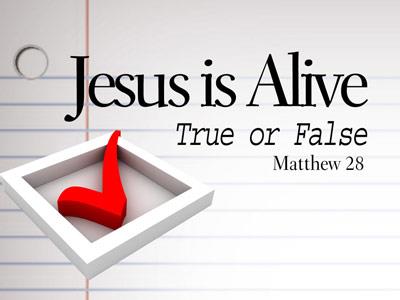-
The Empty Tomb Series
Contributed by Pat Cook on Nov 28, 2017 (message contributor)
Summary: Part 3 in series on Resurrection - what happened that morning chronologically, and what it all means to us.
Mark 16:1-8 – The Empty Tomb
Milton Berle once told a story about hope. Four widows are playing cards in the retirement home they lived in. A good-looking older fellow walks in, bags under each arm. "What’s a good-looking man like you doing here?" one asks.
"I’m moving in," he says.
"Oh," says another. "Where ya from?"
"I’ve been in the can the last fifteen years."
"The can?" they ask.
"Yeah, the can, the clink, the slammer, the state penitentiary."
"Oh," says one. "What did you do?"
"I murdered my wife. I cut her up and buried her in the back yard."
There’s a long pause, and then one of them pipes up: "Oh, so you’re single!"
Sometimes hope runs contrary to common sense. Sometimes holding out hope is silly. You know, some would look at our faith and see a useless hope. To hope in Jesus, to hope in forgiveness, to hope in an empty tomb is useless and silly.
But today I want to show you how it really does make sense to hope in an empty tomb. As we continue to look at the FEAT of Easter, the greatest FEAT of them all, the Resurrection, we come to the letter E – the Empty Tomb. Let’s read from Mark 16:1-8.
Now, this is only one of the versions of the Resurrection. The different writers emphasize different parts and different people within the actual occurrence. I’ll try to synthesize the different elements into one accurate re-telling the events of that 1st Easter morning.
The women – Mary the mother of James, Mary Magdalene, Joanna, Salome, and others – went to the tomb early Sunday morning. They went to anoint Jesus’ body with perfumes and spices. Although they saw from a distance Joseph of Arimathea taking Jesus’ body, perhaps they did not know that Joseph himself prepared Jesus’ body. Or perhaps they wanted to do one last act of service themselves. Either way, they went to say goodbye to their loved leader.
But there was a problem: who would move the stone? The stone weighed 2000 lbs. That would be a problem. But when they got there, they found that it was already moved. Apparently they didn’t feel the earthquake, when an angel rolled back the stone. Well, the guards posted at the tomb sure felt it – and saw the angel too. The angel just plopped down on the stone, and the guards passed out because of fear and shock.
So, by the time the women got there, the grave was open and empty, and the guards were unconscious nearby. The women entered the tomb. Suddenly the angel appeared, along with another one, sitting where Jesus had been. They stood up and said, “Don’t be afraid or alarmed. I know you’re looking for Jesus, who was crucified. But why are you looking for the living among the dead? He is not here – He’s risen! Remember the words He spoke when He was with you in Galilee? He said He would be betrayed into the hands of sinful men and be crucified, but would rise again. Come and see where He was. Now, hurry – go tell His disciples, and especially Peter, that they will see Him in Galilee.”
So they women ran out, trembling, bewildered, confused and afraid. They said nothing to anyone until they reached the place where the disciples were staying. They told them the good news, with Mary Magdalene singling out Peter. Peter and John both ran to the tomb, and just found the strips of linen that Jesus had been wrapped in, which were neatly folded. They both went away confused, but John knew there was something. He thought, just perhaps, that Jesus had risen from the dead.
Eventually Mary Magdalene trickled back to the scene. Peter and John didn’t stop to let her know what they had figured out. She went into the tomb again, and saw the 2 angels again. They asked why she was crying. She said that she didn’t know where Jesus had been taken. Suddenly Jesus appeared behind her, even though she didn’t recognize Him. He spoke her name, and she knew that Jesus was alive. She ran back to tell the good news. Meanwhile, the other women came back to the tomb also. Jesus appeared to them as well.
And the events kept happening. Jesus appeared to Peter that day, as well as to 2 disciples on the road, and to 10 disciples that evening. Virtually every one of His followers by nighttime knew about the empty tomb and the resurrected Jesus.
Now, you see, that this all depends on the empty tomb. This would all be unbelievable if the tomb were not empty. If Jesus had still been in the grave, the Easter Sunday events would have been very different. So would our lives. Our faith rests very much on the empty tomb. Without the empty tomb, our faith would be useless. Writer Paul Althus said, “The resurrection proclamation could not have been maintained in Jerusalem for a single day, for a single hour, if the emptiness of the tomb had not been established as fact.” So, can an intelligent, thinking, rational person believe that the tomb was empty? Can you be intelligent and a Christian? Can a thinking person be a Christian? Yes, absolutely. We can believe in an empty tomb.

 Sermon Central
Sermon Central



